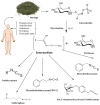A Comparative Review of Key Isothiocyanates and Their Health Benefits
- PMID: 38542669
- PMCID: PMC10974736
- DOI: 10.3390/nu16060757
A Comparative Review of Key Isothiocyanates and Their Health Benefits
Abstract
Isothiocyanates are biologically active products resulting from the hydrolysis of glucosinolates predominantly present in cruciferous vegetables belonging to the Brassicaceae family. Numerous studies have demonstrated the diverse bioactivities of various isothiocyanates, encompassing anticarcinogenic, anti-inflammatory, and antioxidative properties. Nature harbors distinct isothiocyanate precursors, glucosinolates such as glucoraphanin and gluconastrin, each characterized by unique structures, physical properties, and pharmacological potentials. This comprehensive review aims to consolidate the current understanding of Moringa isothiocyanates, mainly 4-[(α-L-rhamnosyloxy) benzyl] isothiocyanate), comparing this compound with other well-studied isothiocyanates such as sulforaphane and phenyl ethyl isothiocyanates. The focus is directed toward elucidating differences and similarities in the efficacy of these compounds as agents with anticancer, anti-inflammatory, and antioxidative properties.
Keywords: anticarcinogenic; antitumor; chemoprevention; isothiocyanate.
Conflict of interest statement
The authors declare no conflicts of interest.
Figures
References
-
- Verhoeven D.T., Goldbohm R.A., van Poppel G., Verhagen H., van den Brandt P.A. Epidemiological studies on brassica vegetables and cancer risk. Cancer Epidemiol. Biomark. Prev. 1996;5:733–748. - PubMed
-
- Bozic D., Baralić K., Živančević K., Miljaković E.A., Ćurčić M., Antonijević B., Djordjević A.B., Bulat Z., Zhang Y., Yang L., et al. Predicting sulforaphane-induced adverse effects in colon cancer patients via in silico investigation. Biomed. Pharmacother. 2022;146:112598. doi: 10.1016/j.biopha.2021.112598. - DOI - PubMed
Publication types
MeSH terms
Substances
LinkOut - more resources
Full Text Sources


